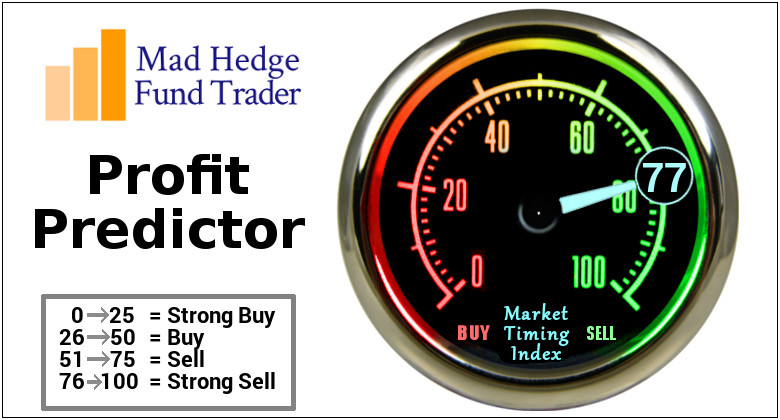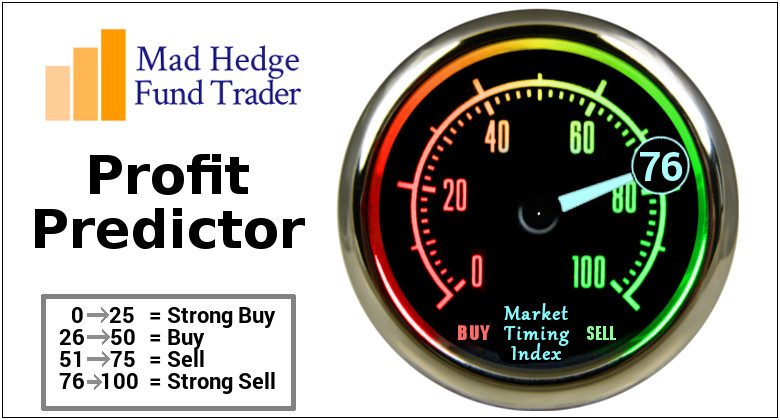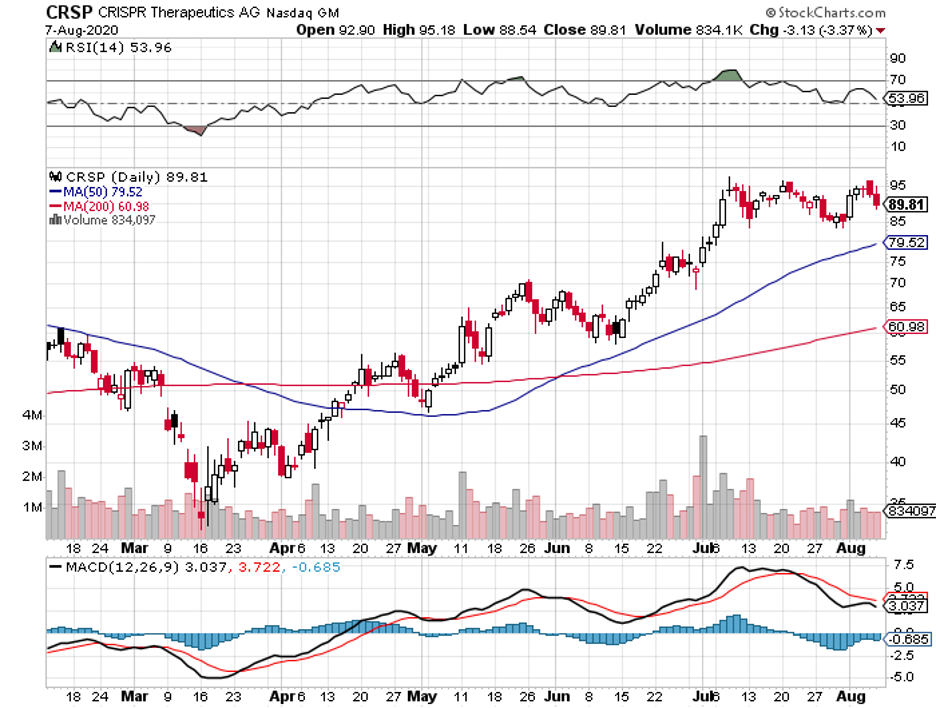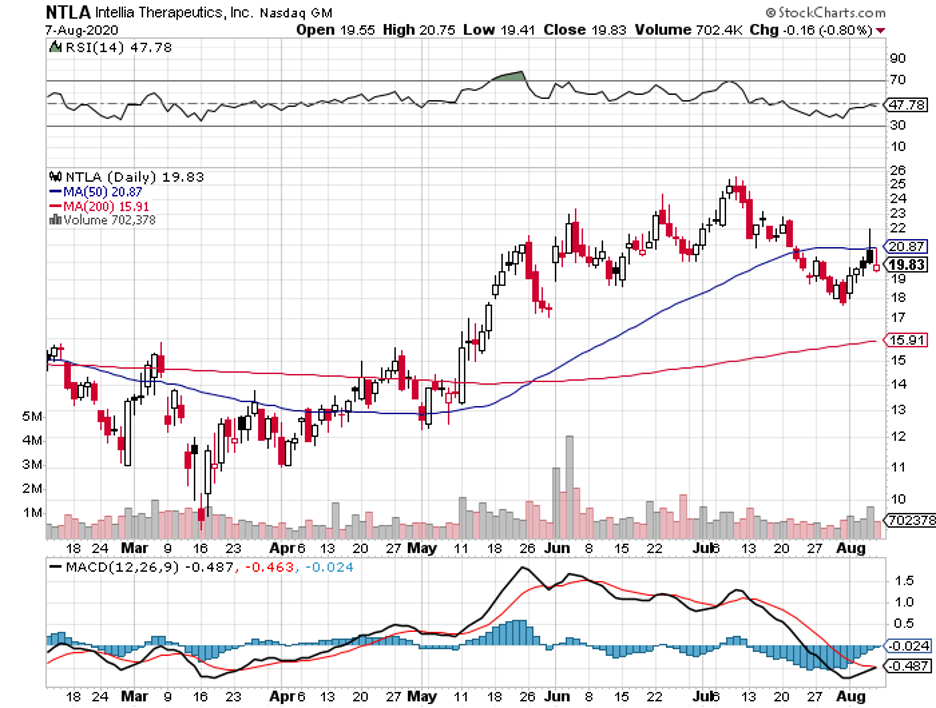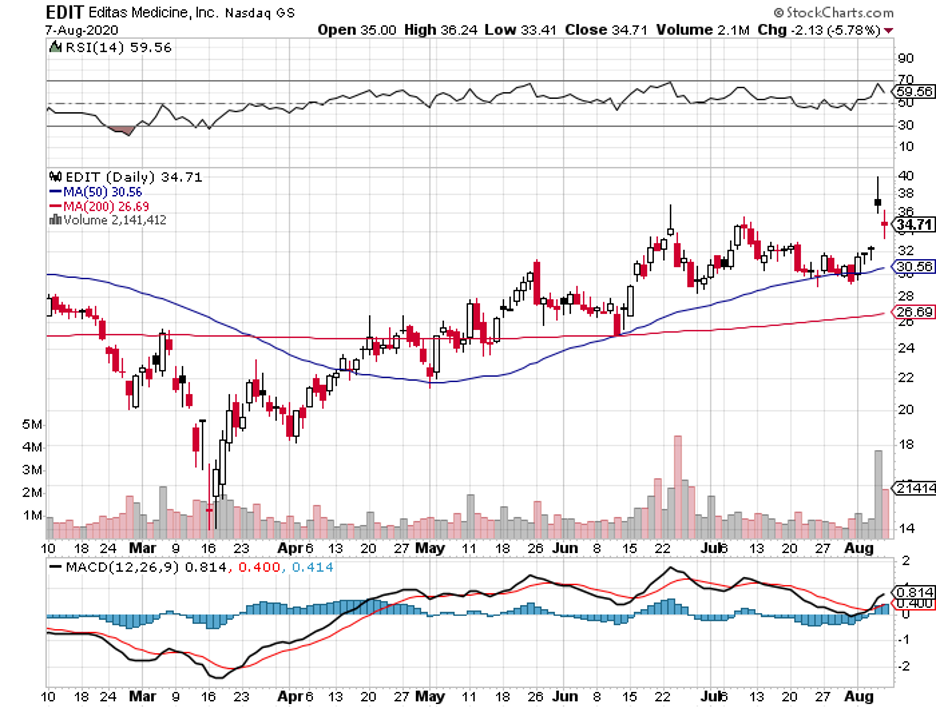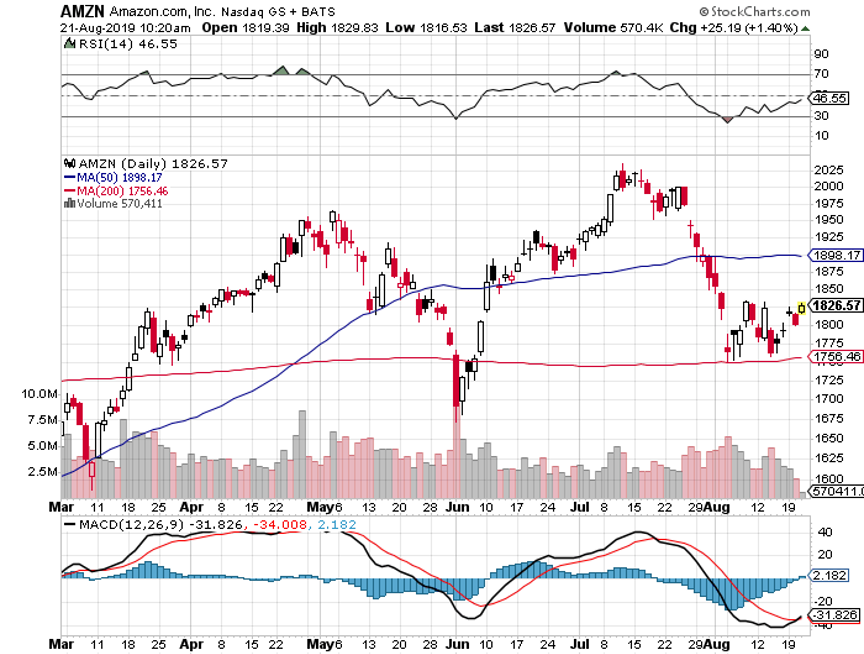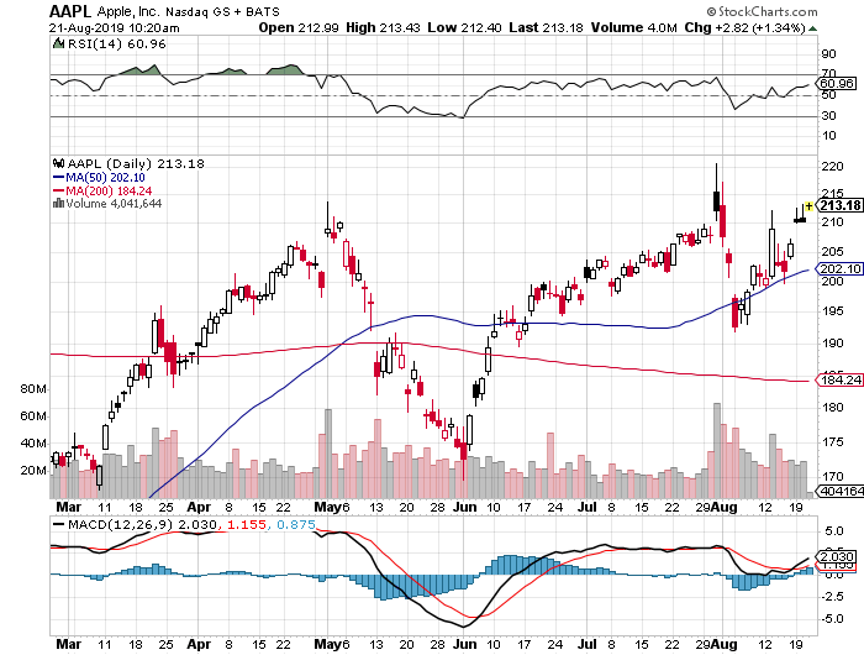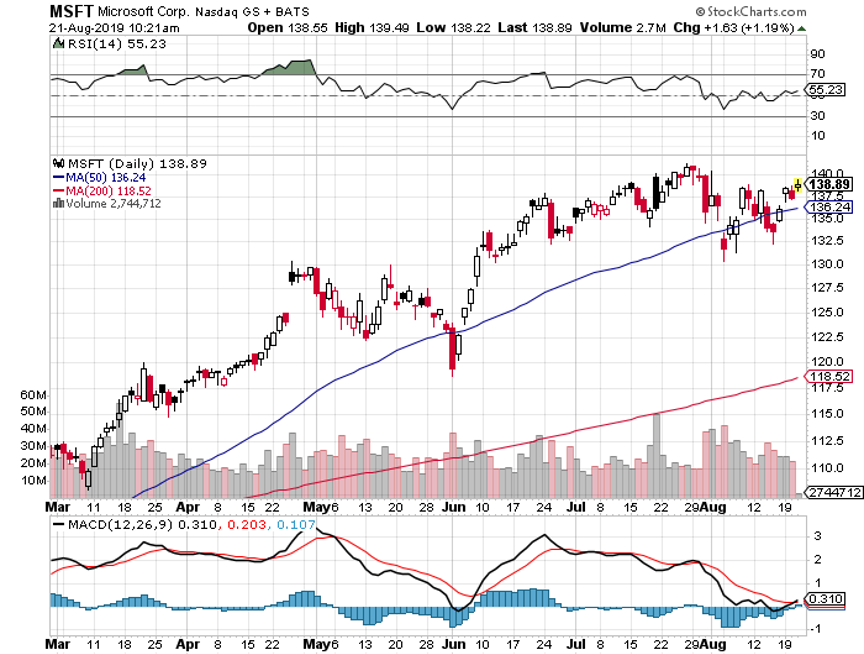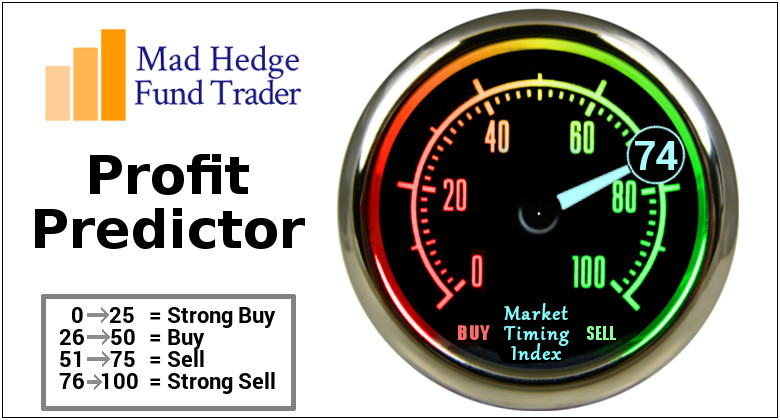While the Diary of a Mad Hedge Fund Trader focuses on investment over a one week to a six-month time frame, Mad Day Trader, provided by Bill Davis, will exploit money-making opportunities over a brief ten minute to three-day window. It is ideally suited for day traders, but can also be used by long-term investors to improve market timing for entry and exit points. Read more
Global Market Comments
August 28, 2020
Fiat Lux
Featured Trade:
(BACK FROM MY 50-MILE HIKE)
When John identifies a strategic exit point, he will send you an alert with specific trade information as to what security to sell, when to sell it, and at what price. Most often, it will be to TAKE PROFITS, but, on rare occasions, it will be to exercise a STOP LOSS at a predetermined price to adhere to strict risk management discipline. Read more
Mad Hedge Biotech & Healthcare Letter
August 27, 2020
Fiat Lux
Featured Trade:
(THE FUTURE OF GENE-EDITING TECHNOLOGY)
(CRSP), (VRTX), (BAYRY), (NTLA), (NVS), (EDIT), (BMY)
There are wise investments, and there are excellent investments.
CRISPR Therapeutics (CRSP) has been proving to qualify in the latter category.
In fact, the company is considered one of the best biotechnology stocks to own during these turbulent times. It is estimated to dominate the gene-editing therapy market, which will reach roughly $11.2 billion in worth by 2025.
Four years ago, CRISPR Therapeutics stock was trading at $14.09. Today, each share is worth $90.35.
This means that CRISPR Therapeutics biotechnology company has been trading for 540% more than its value since it went public in 2016.
This is a remarkable pace for a biotechnology stock, with CRISPR Therapeutics raking in $289 million in trailing 12-month revenue thanks to strategic collaborations.
It even has a decent $890 million stored in cash, with the company reporting a 16% profit margin despite not having any treatment or drug available in the market yet.
More importantly, CRISPR Therapeutics holds a novel position of being under absolutely zero pressure to push a product out the door.
Nonetheless, the investor confidence in CRISPR Therapeutics relies heavily on the company’s leading position in the groundbreaking world of gene-altering treatments.
Basically, the company specializes in creating and developing therapies for genetic diseases with either no cure available or require frequent transfusions.
Looking at the results of the recent tests on the company’s pipeline candidates, CRISPR Therapeutics is projected to transform into a household name in the next five to 10 years.
CRISPR Therapeutics has five cell therapy candidates in the clinical stage. Three of these target immuno-oncology, while the two are designed for genetic blood disorders like beta-thalassemia sickle cell disease.
Among the five, the most advanced is CRISPR Therapeutics’ collaborative work with Vertex Pharmaceuticals (VRTX) on beta-thalassemia therapy CTX001.
This candidate received a fast-track designation from the FDA, with CRISPR Therapeutics releasing promising preliminary results recently.
However, it is another Vertex collaboration drug that actually yielded CRISPR Therapeutics $25 million at the beginning of 2020.
The drug, which is developed to treat muscular dystrophy disorder, is expected to account for approximately $800 million in future milestone payments in the next few years.
Although the genetic blood disorder programs are raking in millions these days, CRISPR Therapeutics’ cancer treatment pipeline offers an even greater potential in terms of stable revenue streams.
The company is utilizing a gene-editing platform, called CRISPR/Cas9, to create “off the shelf” novel chimeric receptor (CAR) T-cells.
If successful, then CRISPR Therapeutics can use a single batch to treat a broad group of cancer patients.
This is groundbreaking because the typical way involves harvesting T-cells from the patients, tailor-fitting the therapies, then re-introducing the cells to the body.
With this technology, CRISPR Therapeutics can easily cover more markets and offer regular treatments for patients within shorter intervals.
That’s why it comes as no surprise that a major biotechnology player like Bayer (BAYR) reached out to the smaller company for a collaboration.
The CAR T-cell market is projected to hit $8.4 billion by 2027, with an estimated compound annual growth rate of roughly 15%.
Specifically, CRISPR Therapeutics expects this product to become a leader in the solid tumor cancer therapy space, pegged to reach $425 billion by 2027.
However, it is not only CRISPR Therapeutics that is widely known in the gene-editing sector.
To date, the company has two close competitors: Intellia Therapeutics (NTLA), which has a strategic partnership with Novartis (NVS), and Editas Medicine (EDIT), which is working alongside Bristol Myers-Squibb (BMY).
Both are also using the CRISPR/Cas9 technology to come up with treatments.
Although Intellia Therapeutics and Editas went public the same year as CRISPR Therapeutics, neither has performed quite as well.
For perspective, CRISPR Therapeutics currently has a market capitalization of $6.3 billion. In comparison, Intellia Therapeutics has $1.13 billion while Editas Medicine has $2.13 billion.
Keep in mind though that clinical-stage companies, particularly in the biotechnology sector, are inherently risky plays.
Among the companies in the space, CRISPR Therapeutics is emerging to be a solid bet not only from a cash perspective but also based on its strong pipeline and profitable collaborations.
Overall, CRISPR Therapeutics is still considered a high-risk option.
Hence, the safest way to invest is to build a carefully hedged portfolio filled with well-researched gene-editing stocks. This will minimize your risks and guarantee your exposure to the upside in case any of your chosen biotechnology companies makes it to the market with a groundbreaking therapy.
Global Market Comments
August 27, 2020
Fiat Lux
Featured Trade:
(WHY YOU MISSED THE TECHNOLOGY BOOM AND WHAT TO DO ABOUT IT NOW),
(AAPL), (AMZN), (MSFT), (NVDA), (TSLA), (WFC), (FB)
I often review the portfolios of new subscribers looking for fundamental flaws in their investment approach and it is not unusual for me to find some real disasters.
The Armageddon scenario was quite popular a decade ago. You know, the philosophy that said that the Dow ($INDU) was plunging to 3,000, the US government would default on its debt (TLT), and gold (GLD) was rocketing to $50,000 an ounce?
Those who stuck with the deeply flawed analysis that justified those conclusions saw their retirement funds turn to ashes.
Traditional value investors also fell into a trap. By focusing only on stocks with bargain-basement earnings multiples, low price to book values, and high visible cash flows, they shut themselves out of technology stocks, far and away the fastest growing sector of the economy.
If they are lucky, they picked up shares in Apple a few years ago when the earnings multiple was still down at ten. But even the Giant of Cupertino hasn’t been that cheap for years.
And here is the problem. Tech stocks defy analysis because traditional valuation measures don’t apply to them.
Let’s start with the easiest metric of all, that of sales. How do you measure the value of sales when a company gives away most of its services for free?
Take Google (GOOG) for example. I bet you all use it. How many of you have actually paid money to Google to use their search function? I would venture none.
What would you pay Google for search if you had to? What is it worth to you to have an instant global search function? Probably at least $100 a year. With 70% of the global search market comprising 2 billion users that means $140 billion a year of potential Google revenues are invisible.
Yes, the company makes a chunk of this back by charging advertisers access to these search users, generating some $38.94 Billion in revenues and $9.95 billion in net income in the most recent quarter. It would have been an $8.2 billion profit without the outrageous $5 billion fine from the European Community.
But much of the increased value of this company is passed on to shareholders not through rising profits or dividend payments but through an ever-rising share price. If you’re looking for dividends, Google doesn’t exist. It is also very convenient that unrealized capital gains are tax-free until the shares are sold.
I’ll tell you another valuation measure that investors have completely missed, that of community. The most successful companies don’t have just customers who buy stuff, they have a community of members who actively participate in a common vision, which is then monetized. There are countless communities out there now making fortunes, you just have to know how to spot them.
Facebook (FB) has created the largest community of people who are willing to share personal information. This permits the creation of affinity groups centered around specific interests, from your local kids’ school activities to municipality emergency alerts, to your preferred political party.
This creates a gigantic network effect that increases the value of Facebook. Each person who joins (FB) makes it worth more, raising the value of the shares, even though they haven’t paid it a penny. Again, it’s advertisers who are footing your tab.
Tesla (TSLA) has 400,000 customers willing to lend it $400 billion for free in the form of deposits on future car purchases because they also share in the vision of a carbon-free economy. When you add together the costs of initial purchase, fuel, and maintenance savings, a new Tesla Model 3 is now cheaper than a conventional gasoline-powered car over its entire life.
REI, a privately held company, actively cultivates buyers of outdoor equipment, teaches them how to use it, then organizes trips. It will then pursue you to the ends of the earth with seasonal discount sales. Whole Foods (WFC), now owned by Amazon (AMZN), does the same in the healthy eating field.
If you spend a lot of your free time in these two stores, as I do, The United States is composed entirely of healthy, athletic, good looking, and long-lived people.
There is another company you know well that has grown mightily thanks to the community effect. That would be the Diary of a Mad Hedge Fund Trader, one of the fastest growing online financial services firms of the past decade.
We have succeeded not because we are good at selling newsletters, but because we have built a global community of like-minded investors with a common shared vision around the world, that of making money through astute trading and investment.
We produce daily research services covering global financial markets, like Global Trading Dispatch and the Mad Hedge Technology Letter. We teach you how to monetize this information with our books like Stocks to Buy for the Coming Roaring Twenties and the Mad Hedge Options Training Course.
We then urge you to action with our Trade Alerts. If you want more hands-on support, you can upgrade to the Concierge Service. You can also meet me in person to discuss your personal portfolios at my Global Strategy Luncheons.
The luncheons are great because long term Mad Hedge veterans trade notes on how best to use the service and inform me on where to make improvements. It’s a blast.
The letter is self-correcting. When we make a mistake, readers let us know in 60 seconds and we can shoot out a correction immediately. The services evolve on a daily basis.
It all comes together to enable customers to make up to 50% to 60% a year on their retirement funds. And guess what? The more money they make, the more products and services they buy from me. This is why I have so many followers who have been with me for a decade or more. And some of my best ideas come from my own subscribers.
So, if you missed technology now, what should you do about it? Recognize what the new game is and get involved. Microsoft (MSFT) with the fastest-growing cloud business offers good value here. Amazon looks like it will eventually hit my $3,000 target. You want to be buying graphics card and AI company NVIDIA (NVDA) on every 10% dip.
You can buy the breakouts now to get involved, or patiently wait until the 10% selloff that usually follows blowout quarterly earnings.
My guess is that tech stocks still have to double in value before their market capitalization of 26% matches their 50% share of US profits. And the technologies are ever hyper-accelerating. That leaves a lot of upside even for the new entrants.
I Finally Found Tech Stocks!
When John identifies a strategic exit point, he will send you an alert with specific trade information as to what security to sell, when to sell it, and at what price. Most often, it will be to TAKE PROFITS, but, on rare occasions, it will be to exercise a STOP LOSS at a predetermined price to adhere to strict risk management discipline. Read more
While the Diary of a Mad Hedge Fund Trader focuses on investment over a one week to a six-month time frame, Mad Day Trader, provided by Bill Davis, will exploit money-making opportunities over a brief ten minute to three-day window. It is ideally suited for day traders, but can also be used by long-term investors to improve market timing for entry and exit points. Read more
Mad Hedge Technology Letter
August 26, 2020
Fiat Lux
Featured Trade:
(THE EMPTY PIPELINE OF TECH INNOVATION)
(AAPL), (FB), (AMZN), (GOOGL), (NFLX), (TSLA), (SNAP), (MSFT), (ORCL), (TWTR)
Legal Disclaimer
There is a very high degree of risk involved in trading. Past results are not indicative of future returns. MadHedgeFundTrader.com and all individuals affiliated with this site assume no responsibilities for your trading and investment results. The indicators, strategies, columns, articles and all other features are for educational purposes only and should not be construed as investment advice. Information for futures trading observations are obtained from sources believed to be reliable, but we do not warrant its completeness or accuracy, or warrant any results from the use of the information. Your use of the trading observations is entirely at your own risk and it is your sole responsibility to evaluate the accuracy, completeness and usefulness of the information. You must assess the risk of any trade with your broker and make your own independent decisions regarding any securities mentioned herein. Affiliates of MadHedgeFundTrader.com may have a position or effect transactions in the securities described herein (or options thereon) and/or otherwise employ trading strategies that may be consistent or inconsistent with the provided strategies.

